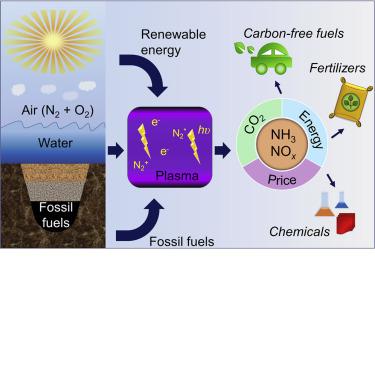Joule ( IF 38.6 ) Pub Date : 2020-12-08 , DOI: 10.1016/j.joule.2020.11.009 Lea R. Winter , Jingguang G. Chen

|
Sustainable nitrogen fixation could offset the significant environmental and societal costs associated with the energy-intensive conventional Haber-Bosch process (HB). This perspective compares the energy requirements, CO2 emissions, and commodity prices associated with alternative plasma-activated ammonia synthesis to those for HB. The threshold efficiency required for a plasma process to become competitive is established for various scenarios of H2 sources, energy sources from natural gas to CO2-free renewable energy, and carbon pricing policies. Economic positive externalities are evaluated for renewable energy-powered modular ammonia production, which is projected to become competitive upon achieving a 6-fold improvement in plasma process efficiency. The technological prospects for achieving the thresholds are discussed, including advancements in plasma-catalyst synergy, direct reactions of N2 with plasma-activated water, and plasma N2 oxidation. A comparison of theoretical energy minima reveals that the energy required for plasma-activated nitrogen fixation might be lower than that for HB.
中文翻译:

通过等离子体激活过程固定N 2
可持续固氮可以抵消与能源密集型常规Haber-Bosch工艺(HB)相关的巨大环境和社会成本。该观点将与替代血浆活化氨合成相关的能源需求,CO 2排放和商品价格与HB进行了比较。针对H 2源,天然气到CO 2的能源等各种情况,确定了等离子体工艺具有竞争力所需的阈值效率免费的可再生能源和碳定价政策。对可再生能源供电的模块化氨生产的经济正外部性进行了评估,预计在等离子工艺效率提高6倍后,该产品将具有竞争力。讨论了达到该阈值的技术前景,包括等离子体催化剂协同作用的进展,N 2与等离子体活化水的直接反应以及等离子体N 2的氧化。对理论最低能量的比较表明,等离子体活化氮固定所需的能量可能低于HB。











































 京公网安备 11010802027423号
京公网安备 11010802027423号